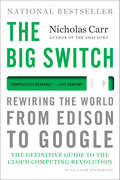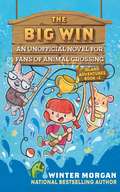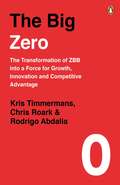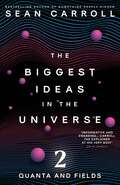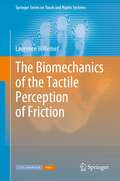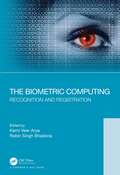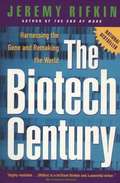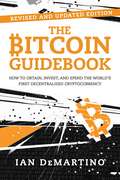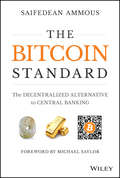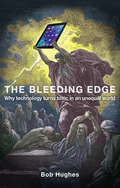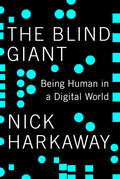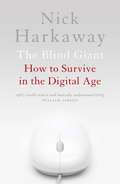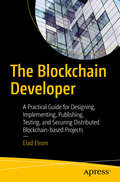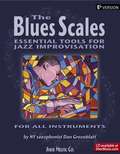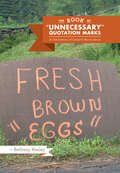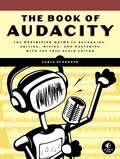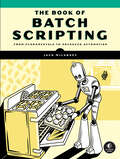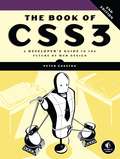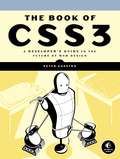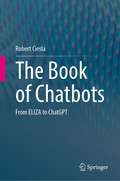- Table View
- List View
The Big Switch: Rewiring the World, from Edison to Google
by Nicholas Carr"Magisterial. . . . Draws an elegant and illuminating parallel between the late-19th-century electrification of America and today's computing world."--Salon Hailed as "the most influential book so far on the cloud computing movement" (Christian Science Monitor), The Big Switch makes a simple and profound statement: Computing is turning into a utility, and the effects of this transition will ultimately change society as completely as the advent of cheap electricity did. In a new chapter for this edition that brings the story up-to-date, Nicholas Carr revisits the dramatic new world being conjured from the circuits of the "World Wide Computer."
The Big Win: An Unofficial Novel for Fans of Animal Crossing (Island Adventures #2)
by Winter MorganThe second installment of a new adventure series for fans of Animal Crossing by bestselling author Winter Morgan!When Janey the cat arrives on Furtopia and announces a fishing contest, Alana is reluctant to join. Alana knows she can become hyper-focused on winning contests and is trying to change her competitive ways. Also, Alana just learned how to fish, and she doesn&’t think she has the skills to catch enough fish to win the contest. She joins the contest anyway, and soon finds herself spending so much time preparing for the contest that she doesn't have any time for her friends. Lar's birthday party is coming, and Happy and Carl can't get Alana to help them plan it. All of Alana&’s problems seem to be solved when her new friend Bobby, a sporty bear, convinces Alana to hire him as her trainer. Bobby&’s training plan allows Alana enough time to help her friends and possibly win the contest. However, she soon realizes that Bobby&’s way of winning might not be honest. There's not much time left, and Alana must decide between playing fairly or playing to win.
The Big Zero: The Transformation of ZBB into a Force for Growth, Innovation and Competitive Advantage
by Kris Timmermans Chris Roark Rodrigo AbdallaDo you want to achieve startup speed at enterprise scale? Growth. It's what every company strives for. But it's become more and more elusive as companies struggle to hit their projected growth rates in an increasingly competitive market. While zero-based budgeting (ZBB) has been wielded for decades to cut costs, it falls short when it comes to spurring growth. But a zero-based mindset (ZBx) does that and more. ZBx facilitates forensic oversight into resource allocation that funnels savings back into growth initiatives and encourages new sources of innovation. The Big Zero shows how a ZBx approach focuses on agility over austerity, visibility over guesswork and the future over the past to fuel growth and competitiveness.
The Biggest Ideas in the Universe 2: Quanta and Fields
by Sean CarrollTHE NEW YORK TIMES BESTSELLER &‘Neat, and extremely simple: only a deep thinker such as Sean Carroll could introduce the complexity of Einstein&’s general relativity in such a luminous and straightforward manner.&’ Carlo Rovelli, author of Seven Brief Lessons on Physics Immense, strange and infinite, the world of modern physics often feels impenetrable to the undiscerning eye – a jumble of muons, gluons and quarks, impossible to explain without several degrees and a research position at CERN. But it doesn&’t have to be this way! Allow world-renowned theoretical physicist and bestselling author Sean Carroll to guide you through the biggest ideas in the universe. Elegant and simple, Carroll unravels a web of theory to get to the heart of the truths they represent about the world around us. — In Quanta and Fields, the second in this landmark trilogy, Carroll delves into the baffling and beautiful world of quantum mechanics. From Schrödinger to Feynman, Carroll travels through the quantum revolution with the greatest minds of the twentieth century. Exploring how several decades of research overturned centuries of convention, Carroll provides a dazzling tour of the most exciting ideas in modern science.
The Biomechanics of the Tactile Perception of Friction (Springer Series on Touch and Haptic Systems)
by Laurence WillemetHumans rely on their sense of touch to perceive subtle movements and micro slippages to manipulate an impressive range of objects. This incredible dexterity relies on fast and unconscious adjustments of the grip force that holds an object strong enough to avoid a catastrophic fall yet gentle enough not to damage it. The Biomechanics of the Tactile Perception of Friction covers how the complex mechanical interaction is perceived by the nervous system to quickly infer the state of the contact for a swift and precise regulation of the grip. The first part focuses on how humans assess friction at the contact initialization and the second part highlights an efficient coding strategy that the nervous system might use to continuously adjust the grip force to keep a constant safety margin before slippage. Taken together, these results reveal how the perception of frictional information is encoded in the deformation of our skin. The findings are useful for designing bio-inspired tactile sensors for robotics or prosthetics and for improving haptic human-machine interactions.
The Biometric Computing: Recognition and Registration
by Robin Singh Bhadoria Karm Veer Arya"The Biometric Computing: Recognition & Registration" presents introduction of biometrics along with detailed analysis for identification and recognition methods. This book forms the required platform for understanding biometric computing and its implementation for securing target system. It also provides the comprehensive analysis on algorithms, architectures and interdisciplinary connection of biometric computing along with detailed case-studies for newborns and resolution spaces. The strength of this book is its unique approach starting with how biometric computing works to research paradigms and gradually moves towards its advancement. This book is divided into three parts that comprises basic fundamentals and definitions, algorithms and methodologies, and futuristic research and case studies. Features: A clear view to the fundamentals of Biometric Computing Identification and recognition approach for different human characteristics Different methodologies and algorithms for human identification using biometrics traits such as face, Iris, fingerprint, palm print, voiceprint etc. Interdisciplinary connection of biometric computing with the fields like deep neural network, artificial intelligence, Internet of Biometric Things, low resolution face recognition etc. This book is an edited volume by prominent invited researchers and practitioners around the globe in the field of biometrics, describes the fundamental and recent advancement in biometric recognition and registration. This book is a perfect research handbook for young practitioners who are intending to carry out their research in the field of Biometric Computing and will be used by industry professionals, graduate and researcher students in the field of computer science and engineering.
The Biotech Century: Harnessing the Gene and Remaking the World
by Jeremy RifkinIn this seminal book, Jeremy Rifkin explores the epic marriage between computer technology and genetic engineering, and the historic transition into the Age of Biotechnology. Already, Rifkin explains, our economy is undergoing a massive shift away from the Industrial Age and into an era in which giant life-science corporations are fashioning a bioindustrial world. Humanity is on the brink of wielding greater control over the shape of life--how we are born; how our food supply is created; the traits our children may have--than has ever been imagined. But with each step into this new era, we must ask ourselves: At what cost?
The Birth of Computer Vision
by James E. DobsonA revealing genealogy of image-recognition techniques and technologies Today&’s most advanced neural networks and sophisticated image-analysis methods come from 1950s and &’60s Cold War culture—and many biases and ways of understanding the world from that era persist along with them. Aerial surveillance and reconnaissance shaped all of the technologies that we now refer to as computer vision, including facial recognition. The Birth of Computer Vision uncovers these histories and finds connections between the algorithms, people, and politics at the core of automating perception today.James E. Dobson reveals how new forms of computerized surveillance systems, high-tech policing, and automated decision-making systems have become entangled, functioning together as a new technological apparatus of social control. Tracing the development of a series of important computer-vision algorithms, he uncovers the ideas, worrisome military origins, and lingering goals reproduced within the code and the products based on it, examining how they became linked to one another and repurposed for domestic and commercial uses. Dobson includes analysis of the Shakey Project, which produced the first semi-autonomous robot, and the impact of student protest in the early 1970s at Stanford University, as well as recovering the computer vision–related aspects of Frank Rosenblatt&’s Perceptron as the crucial link between machine learning and computer vision.Motivated by the ongoing use of these major algorithms and methods, The Birth of Computer Vision chronicles the foundations of computer vision and artificial intelligence, its major transformations, and the questionable legacy of its origins. Cover alt text: Two overlapping circles in cream and violet, with black background. Top is a printed circuit with camera eye; below a person at a 1977 computer.
The Bitcoin Guidebook: How to Obtain, Invest, and Spend the World?s First Decentralized Cryptocurrency
by Ian DeMartino2018 Revised EditionBitcoin has made early investors like the Winkelvoss twins millions in a matter of minutes in the past year and has the potential to transform the financial landscape. It's not too late to get in on the action. Bitcoin is not another payment processor. Like the Internet, Bitcoin is a technology that runs through a distributed network. No one controls it, and no one can shut it down. Bitcoin has been called the currency of the Internet, but it is much more powerful than that. More astute observers have called it the Internet of currency. This new, revised edition of The Bitcoin Guidebook has the most up-to-date info and recommended approaches for anyone who doesn't want to be left behind in the next technological revolution. It is an easy-to-read, easy-to-understand guide that explains everything the reader needs to know about how Bitcoin and other digital currencies work, what they can be used for, and how they will shape our society in the future. Topics covered include: The digital currency's origins, past, present, and future The revolutionary blockchain technology behind Bitcoin, and its future for the industries of music, arts, photography, and more How to obtain and invest in Bitcoin or other cryptocurrency How and where to spend Bitcoin Bitcoin's relationship with the seedy Internet underground Alternative digital currencies, like ethereum, ripple, litecoin, IOTA or dashHow governments and financial institutions may react to cryptocurrency in the future How to interact with other Bitcoin owners on exchanges like Coinbase
The Bitcoin Standard: The Decentralized Alternative to Central Banking
by Saifedean AmmousWhen a pseudonymous programmer introduced “a new electronic cash system that’s fully peer-to-peer, with no trusted third party” to a small online mailing list in 2008, very few paid attention. Ten years later, and against all odds, this upstart autonomous decentralized software offers an unstoppable and globally-accessible hard money alternative to modern central banks. The Bitcoin Standard analyzes the historical context to the rise of Bitcoin, the economic properties that have allowed it to grow quickly, and its likely economic, political, and social implications.
The Bite in the Apple: A Memoir of My Life with Steve Jobs
by Chrisann BrennanAn intimate look at the life of Steve Jobs by the mother of his first child providing rare insight into Jobs's formative, lesser-known years.Steve Jobs was a remarkable man who wanted to unify the world through technology. For him, the point was to set people free with tools to explore their own unique creativity. Chrisann Brennan knows this better than anyone. She met him in high school, at a time when Jobs was passionately aware that there was something much bigger to be had out of life, and that new kinds of revelations were within reach.The Bite in the Apple is the very human tale of Jobs's ascent and the toll it took, told from the author's unique perspective as his first girlfriend, co-parent, friend, and—like many others—object of his cruelty. Brennan writes with depth and breadth, and she doesn't buy into all the hype. She talks with passion about an idealistic young man who was driven to change the world, about a young father who denied his own child, and about a man who mistook power for love. Chrisann Brennan's intimate memoir provides the reader with a human dimension to Jobs' myth. Finally, a book that reveals a more real Steve Jobs.
The Bleeding Edge: Why Technology Turns Toxic in an Unequal World
by Bob HughesIt’s hammered into us from birth that ‘all good things come at a price’. Today, that price looks apocalyptic, with wars, exploitation and environmental collapse in every part of the globe. Some suggest that the carnage is “a price worth paying” for technological progress. No pain, no gain. But technology is precisely the business of minimising the costs and impacts of existence… and by whole orders of magnitude. By now, all human beings should be leading creative, leisure-filled lives in a pristine world of burgeoning diversity. So how did it go so wrong? In a word, inequality. In The Bleeding Edge, Bob Hughes argues that unequal societies are incapable of using new technologies well. Wherever elites exist, self-preservation decrees that they must take control of new technologies to protect and entrench their status, rather than satisfy people’s needs. Hughes pursues the latest discoveries about the effects of social inequality on human health, into the field of human environmental impact, and traces today’s ecological crisis back to the rise of the world’s first elites, 5,000 years ago. He argues that new technologies have never emerged from elites or from the clash of competitive forces, but from largely voluntary, egalitarian collaborations of the kind that produced the world’s first working computers. Finally, Hughes shows that an egalitarian world is not ‘pie in the sky' but our evolutionary homeland, the glue that holds societies together, and the “cradle of invention” from which all our best ideas emerge. The book concludes: ‘Let’s assume that the commitment to human equality that’s written into the Universal Declaration of Human Rights means exactly what it says, and take it from there.’
The Blender Python API
by Chris ConlanUnderstand Blender's Python API to allow for precision 3D modeling and add-on development. Follow detailed guidance on how to create precise geometries, complex texture mappings, optimized renderings, and much more.This book is a detailed, user-friendly guide to understanding and using Blender’s Python API for programmers and 3D artists. Blender is a popular open source 3D modeling software used in advertising, animation, data visualization, physics simulation, photorealistic rendering, and more. Programmers can produce extremely complex and precise models that would be impossible to replicate by hand, while artists enjoy numerous new community-built add-ons.The Blender Python API is an unparalleled programmable visualization environment. Using the API is made difficult due to its complex object hierarchy and vast documentation. Understanding the Blender Python API clearly explains the interface. You will become familiar with data structures and low-level concepts in both modeling and rendering with special attention given to optimizing procedurally generated models. In addition, the book:Discusses modules of the API as analogs to human input modes in BlenderReviews low-level and data-level manipulation of 3D objects in Blender PythonDetails how to deploy and extend projects with external librariesProvides organized utilities of novel and mature API abstractions for general use in add-on developmentWhat You’ll LearnGenerate 3D data visualizations in Blender to better understand multivariate data and mathematical patterns.Create precision object models in Blender of architectural models, procedurally generated landscapes, atomic models, etc.Develop and distribute a Blender add-on, with special consideration given to careful development practicesPick apart Blender’s 3D viewport and Python source code to learn about API behaviorsDevelop a practical knowledge of 3D modeling and rendering conceptsHave a practical reference to an already powerful and vast APIWho This Book Is ForPython programmers with an interest in data science, game development, procedural generation, and open-source programming as well as programmers of all types with a need to generate precise 3D models. Also for 3D artists with an interest in programming or with programming experience and Blender artists regardless of programming experience.
The Blind Giant
by Nick HarkawayNick Harkaway, author of Angelmaker, presents a rousing and energizing look at how we can meaningfully and constructively engage with technology--creating an essential handbook for anyone trying to be human in a digital age. Some say our devices will lead us to ruin: isolating us from our neighbors, warping communication, delivering an unregulated flood of information that will destroy our humanity. Some say they will be our salvation: enabling global communication and social engagement, putting all the world's facts at our fingertips, and erasing the barriers that divide us, bringing out the best qualities of humanity. In The Blind Giant, novelist and blogger Nick Harkaway takes us on a lucid, insightful and personal tour of how we live our lives in our technology-obsessed culture. A self-described "missing link" between the pre-Internet generation and the "digital natives" who have grown up with technology, Nick is an enthusiastic guide to digital culture who weaves together examples from literature, psychology, neurology, sociology, history, and his own life while exploring the hazards and joys of the human-machine relationship. In the final analysis, whether we meaningfully engage with the machines we have created, or risk living in a world which is designed to serve computers and corporations rather than people, this book is a must-read for anyone concerned with our digital future.
The Blind Giant: How to Survive in the Digital Age
by Nick HarkawayThe digital age. An age of isolation, warped communication, disintegrating community. Where unfiltered and unregulated information pours relentlessly into our lives, destroying what it means to be human. Or an age of marvels. Where there is a world of wonder at our fingertips. Where we can communicate across the globe, learn in the blink of an eye, pull down the barriers that divide us and move forward together. Whatever your reaction to technological culture, the speed with which our world is changing is both mesmerising and challenging. In The Blind Giant, novelist and tech blogger Nick Harkaway draws together fascinating and disparate ideas to challenge the notion that digital culture is the source of all our modern ills, while at the same time showing where the dangers are real and suggesting how they can be combated. Ultimately, the choice is ours: engage with the machines that we have created, or risk creating a world which is designed for corporations and computers rather than people. This is an essential handbook for everyone trying to be human in a digital age.
The Blind Giant: How to Survive in the Digital Age
by Nick HarkawayThe digital age. An age of isolation, warped communication, disintegrating community. Where unfiltered and unregulated information pours relentlessly into our lives, destroying what it means to be human. Or an age of marvels. Where there is a world of wonder at our fingertips. Where we can communicate across the globe, learn in the blink of an eye, pull down the barriers that divide us and move forward together. Whatever your reaction to technological culture, the speed with which our world is changing is both mesmerising and challenging. In The Blind Giant, novelist and tech blogger Nick Harkaway draws together fascinating and disparate ideas to challenge the notion that digital culture is the source of all our modern ills, while at the same time showing where the dangers are real and suggesting how they can be combated. Ultimately, the choice is ours: engage with the machines that we have created, or risk creating a world which is designed for corporations and computers rather than people. This is an essential handbook for everyone trying to be human in a digital age.
The Blockchain Developer: A Practical Guide for Designing, Implementing, Publishing, Testing, and Securing Distributed Blockchain-based Projects
by Elad ElromBecome a Blockchain developer and design, build, publish, test, maintain and secure scalable decentralized Blockchain projects using Bitcoin, Ethereum, NEO, EOS and Hyperledger. This book helps you understand Blockchain beyond development and crypto to better harness its power and capability. You will learn tips to start your own project, and best practices for testing, security, and even compliance. Immerse yourself in this technology and review key topics such as cryptoeconomics, coding your own Blockchain P2P network, different consensus mechanisms, decentralized ledger, mining, wallets, blocks, and transactions. Additionally, this book provides you with hands-on practical tools and examples for creating smart contracts and dApps for different blockchains such as Ethereum, NEO, EOS, and Hyperledger. Aided by practical, real-world coding examples, you’ll see how to build dApps with Angular utilizing typescript from start to finish, connect to the blockchain network locally on a test network, and publish on the production mainnet environment. Don’t be left out of the next technology revolution – become a Blockchain developer using The Blockchain Developer today. What You’ll Learn Explore the Blockchain ecosystem is and the different consensus mechanismsCreate miners, wallets, transactions, distributed networks and DAppsReview the main features of Bitcoin: Ethereum, NEO and EOS, and Hyperledger areInteract with popular node clients as well as implementing your own BlockchainPublish and test your projects for security and scalability Who This Book Is For Developers, architects and engineers who are interested in learning about Blockchain or implementing Blockchain into a new greenfield project or integrating Blockchain into a brownfield project. Technical entrepreneurs, technical investors or even executives who want to better understand Blockchain technology and its potential.
The Blockchain and the New Architecture of Trust (Information Policy)
by Kevin WerbachHow the blockchain—a system built on foundations of mutual mistrust—can become trustworthy.The blockchain entered the world on January 3, 2009, introducing an innovative new trust architecture: an environment in which users trust a system—for example, a shared ledger of information—without necessarily trusting any of its components. The cryptocurrency Bitcoin is the most famous implementation of the blockchain, but hundreds of other companies have been founded and billions of dollars invested in similar applications since Bitcoin's launch. Some see the blockchain as offering more opportunities for criminal behavior than benefits to society. In this book, Kevin Werbach shows how a technology resting on foundations of mutual mistrust can become trustworthy. The blockchain, built on open software and decentralized foundations that allow anyone to participate, seems like a threat to any form of regulation. In fact, Werbach argues, law and the blockchain need each other. Blockchain systems that ignore law and governance are likely to fail, or to become outlaw technologies irrelevant to the mainstream economy. That, Werbach cautions, would be a tragic waste of potential. If, however, we recognize the blockchain as a kind of legal technology that shapes behavior in new ways, it can be harnessed to create tremendous business and social value.
The Blues Scales - Eb Version
by Sher Music Dan GreenblattThe only book that shows how the Blues Scales (Major and Minor) are used to create jazz solos. Designed to help beginners quickly learn how to create meaningful solos without having to first master all the scales and chords of a tune. Great transcriptions of solo phrases by Miles Davis, Dave Sanborn, Dizzy Gillespie, etc. showing how the Blues Scales are used. The accompanying CD has the author and his NY rhythm section demonstrating each exercise, and also great as a jazz play-along! Endorsed by Michael Brecker, Jamey Aebersold, etc.
The Book of "Unnecessary" Quotation Marks: A Celebration of Creative Punctuation
by Bethany KeeleyFrom the popular blog, a hilarious and horrifying survey of quotation mark abuse in all its forms.From the sarcastic to the suggestive, here are quotation marks as we love them best, doing horrible damage to the English language. Who wouldn’t have second thoughts about ordering the “hamburger” on the diner’s menu? Would it be best to skip the “blowout” sale at the department store? What hidden price must be paid for something marked “free”? Assembled by the creator of the wildly popular “Blog” of “Unnecessary” Quotation Marks, this book surveys the havoc wreaked by quotation marks on signs, menus, placards, and posters that leave reality upended by supposed “facts.” This smarty-pants guide is “perfect” for desperate grammarians, habitual air quoters, and anyone who appreciates a good laugh.
The Book of Audacity: Record, Edit, Mix, and Master with the Free Audio Editor
by Carla SchroderThe Book of Audacity is the definitive guide to Audacity, the powerful, free, cross-platform audio editor. Audacity allows anyone to transform their Windows, Mac, or Linux computer into a powerful recording studio.The Book of Audacity is the perfect book for bands on a budget, solo artists, audiophiles, and anyone who wants to learn more about digital audio. Musician and podcaster Carla Schroder will guide you through a range of fun and useful Audacity projects that will demystify that geeky audio jargon and show you how to get the most from Audacity.You’ll learn how to:–Record podcasts, interviews, and live performances–Be your own backing band or chorus–Edit, splice, mix, and master multitrack recordings–Create super high-fidelity and surround-sound recordings–Digitize your vinyl or tape collection and clean up noise, hisses, and clicks–Create custom ringtones and sweet special effectsIn addition, you’ll learn how to choose and use digital audio hardware like mics and preamps, and tune your computer for flawless audio performance. You’ll also find out how to package your work for digital distribution, whether you want to share a podcast through iTunes or sell your own CDs. Become your own producer with The Book of Audacity. The fun starts now.
The Book of Batch Scripting: From Fundamentals to Advanced Automation
by Jack McLarneyThis fast-paced, hands-on, quirky introduction to Windows&’ Batch scripting language is ideal for coders of all skill levels.In this era of advanced programming languages, the simplicity, universality, and efficiency of Batch scripting holds undeniable value.Whether you&’re maintaining legacy systems or seeking to understand the foundations of command line automation, The Book of Batch Scripting shows you how to become proficient with this tool included in every version of Windows.As you work through the book, you will:Write a simple .bat file that performs a daily task with just a couple of mouse clicksDelve into variables and data types, and learn how a variable can possess two values at once—and why you should careLearn how to manage and collect data on files and directories either locally or on a networkHarness the power of the for command to build complex loops with just a few lines of codeExplore advanced topics like recursion, performing text searches, and even learn how to write a .bat file that writes a .bat fileExtend Batch to use features like booleans, floats, operators, arrays, hash tables, stacks, queues, and even object-oriented designWritten for beginners and experts alike, The Book of Batch Scripting will have you streamlining your workflow and writing effective code in no time. This simple but powerful tool is about to make your life a little bit easier and more fun.Requires: Microsoft Windows
The Book of CSS3, 2nd Edition: A Developer's Guide to the Future of Web Design
by Peter GasstonCSS3 is the technology behind most of the eye-catching visuals on the Web. But the docs can be dry, murky, and full of dastardly caveats for inconsistent browser implementations.This completely updated second edition of the best-selling Book of CSS3 distills the dense technical language of the CSS3 specification into plain English and shows you what CSS3 can do now, in all major browsers. You’ll find fully revised coverage of the updated syntax of gradients, grids, and flexible box layout, as well as all-new chapters on values and sizing, and graphical effects like filter effects and blend modes.With an abundance of real-world examples and a focus on the principles of good design, The Book of CSS3 will help you expand your CSS skills, as you learn how to:–Style text with custom font choices, drop shadows, and other effects–Create, position, and resize background images on the fly–Spice up static web pages with event-driven transitions and animations–Apply 2D and 3D transformations to text and images–Use linear and radial gradients to create smooth color transitions–Take control of layout with grids, columns, and flexible alignment–Tailor a website’s appearance to every type of web-capable deviceThe companion website includes up-to-date browser compatibility charts, links to tutorials and resources, and live CSS3 examples.The Web can be an ugly place. Make it pretty with The Book of CSS3.
The Book of CSS3: A Developer's Guide to the Future of Web Design
by Peter GasstonCSS3 is behind most of the eye-catching visuals on the Web today, but the official documentation can be dry and hard to follow and browser implementations are scattershot at best.The Book of CSS3 distills the dense technical language of the CSS3 specification into plain English and shows you what CSS3 can do right now, in all major browsers. With real-world examples and a focus on the principles of good design, it extends your CSS skills, helping you transform ordinary markup into stunning, richly-styled web pages.You'll master the latest cutting-edge CSS3 features and learn how to:–Stylize text with fully customizable outlines, drop shadows, and other effects–Create, position, and resize background images on the fly– Spice up static web pages with event-driven transitions and animations–Apply 2D and 3D transformations to text and images–Use linear and radial gradients to create smooth color transitions–Tailor a website's appearance to smartphones and other devicesA companion website includes up-to-date browser compatibility charts and live CSS3 examples for you to explore.The Web can be an ugly place—add a little style to it with The Book of CSS3.
The Book of Chatbots: From ELIZA to ChatGPT
by Robert CieslaPrimitive software chatbots emerged in the 1960s, evolving swiftly through the decades and becoming able to provide engaging human-to-computer interactions sometime in the 1990s. Today, conversational technology is ubiquitous in many homes. Paired with web-searching abilities and neural networking, modern chatbots are capable of many tasks and are a major driving force behind machine learning and the quest for strong artificial intelligence, also known as artificial general intelligence (AGI).Sophisticated artificial intelligence is changing the online world as advanced software chatbots can provide customer service, research duties, and assist in healthcare. Modern chatbots have indeed numerous applications — including those of a malicious nature. They can write our essays, conduct autonomous scams, and potentially influence politics.The Book of Chatbots is both a retrospective and a review of current artificial intelligence-driven conversational solutions. It explores their appeal to businesses and individuals as well as their greater social aspects, including the impact on academia. The book explains all relevant concepts for readers with no previous knowledge in these topics. Unearthing the secrets of virtual assistants such as the (in)famous ChatGPT and many other exciting technologies, The Book of Chatbots is meant for anyone interested in the topic, laypeople and IT-enthusiasts alike.
